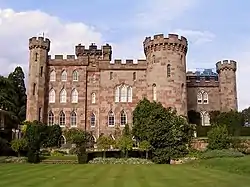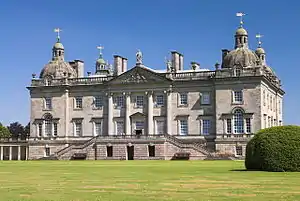George Cholmondeley, 2nd Marquess of Cholmondeley
George Horatio Cholmondeley, 2nd Marquess of Cholmondeley, PC (/ˈtʃʌmli/; 16 January 1792 – 8 May 1870), styled Viscount Malpas until 1792 and Earl of Rocksavage between 1792 and 1827, was a British peer and Lord Great Chamberlain of England between 1830 and 1838. Before being called to the House of Lords, he was a Tory Member of Parliament from 1817 through 1821.[1]
The Marquess of Cholmondeley | |
|---|---|
 The Earl of Rocksavage, 1821, from a portrait of the coronation of George IV | |
| Lord Great Chamberlain of England | |
| In office 19 July 1830 – 20 June 1837 | |
| Monarch | William IV |
| Preceded by | Baron Willoughby de Eresby |
| Succeeded by | Baron Willoughby de Eresby |
| Member of Parliament for Castle Rising | |
| In office 1817–1821 | |
| Personal details | |
| Born | George Horatio Cholmondeley 16 January 1792 Paris, France |
| Died | 8 May 1870 (aged 78) Cholmondeley, Cheshire |
| Resting place | Malpas, Cheshire |
| Nationality | British |
| Political party | Conservative |
| Spouse(s) | Caroline Campbell
(m. 1812; died 1815)Susan Somerset (m. 1830) |
| Parents |
|
| Residence | |
Background
Cholmondeley was a direct descendant of Sir Robert Walpole, the first Prime Minister of Great Britain. He was the eldest son of George James Cholmondeley, who had been created the first Marquess of Cholmondeley in 1815. His mother was the former Lady Georgiana Charlotte Bertie, second daughter and coheir of Peregrine Bertie, 3rd Duke of Ancaster and Kesteven.[2] Lord George was educated at Eton, leaving in 1805.[1]
He participated in the coronation of King George IV in 1821, as one of eight eldest sons of peers holding the king's train. The others were the Earl of Surrey, Marquess of Douro, Viscount Cranborne, Earl of Brecknock, Earl of Uxbridge, Earl of Rawdon, Viscount Ingestre and Lord Francis Conyngham.
Personal life
.jpg.webp)
After a brief interest in Catholicism, Cholmondeley became a devout Methodist.[1]
Cholmondeley married Caroline Campbell, second daughter of Sir Colin Campbell, on 20 October 1812, in Gibraltar. She died on 12 October 1815.[1]
On 11 May 1830, he married Lady Susan Caroline Somerset, fourth daughter of Henry Charles Somerset, 6th Duke of Beaufort. Both of his marriages were childless.[2] The Dowager Marchioness Susan survived her husband by 16 years; she died in 1886.
Career
In 1817, Cholmondeley was elected to the House of Commons for Castle Rising, a seat he held until 1821, when he was called to the House of Lords through a writ of acceleration in his father's junior title of Baron Newburgh. George's father stipulated that his eldest son replace him as a condition of his own resignation, to accommodate Henry Conyngham, 1st Marquess Conyngham, whose wife, Elizabeth, was the mistress of King George. Cholmondeley's younger brother, William Henry, was reportedly his father's favourite, and it was said that their father wanted his elder son out of the way "so that his second and favourite son, Lord Henry, may come into Parliament," which he did in 1822.[1]
In 1830, Cholmondeley was admitted to the Privy Council. In addition, he held the office of Constable of Castle Rising between 1858 and 1870.[1]
Lands and estates


The family seats are Houghton Hall in Norfolk, and Cholmondeley Castle, which is surrounded by a 7,500 acres (30 km2) estate near Malpas, Cheshire.[3]
The 2nd Marquess died in May 1870, aged 78, and was succeeded in his lands, estates and titles by his younger brother Henry.[1]
Position at court
One moiety part of the ancient office of Lord Great Chamberlain is a Cholmondeley inheritance.[4] This hereditary honour came into the Cholmondeley family through the marriage of the first Marquess of Cholmondeley to Lady Georgiana Charlotte Bertie, daughter of Peregrine Bertie, 3rd Duke of Ancaster and Kesteven.[5] The second, fourth, fifth, sixth and seventh holders of the marquesate have all held this office.
Notes
- "CHOLMONDELEY, George Horatio, earl of Rocksavage (1792–1870)". History of Parliament. Institute of Historical Research. Retrieved 4 March 2015.
- Lodge, Edmund. (1877). The Peerage and Baronetage of the British Empire as at Present Existing, p. 125.
- Caroline, Donald. "The new garden at Houghton Hall, King’s Lynn, Norfolk," The Times (UK). 11 May 2008.
- Notes and Queries (1883 Jan–Jun), p. 42.
- Portcullis Archived 20 December 2008 at the Wayback Machine: Deed of Covenant and Agreement between Lord Willoughby de Eresby, The Dowager Marchioness of Cholmondeley and the Marquis of Cholmondeley re the exercise of the Office of Hereditary Great Chamberlain (16 May 1829). Archived 24 September 2015 at the Wayback Machine
References
- Debrett, John, Charles Kidd, David Williamson. (1990). Debrett's Peerage and Baronetage. New York: Macmillan. ISBN 978-0-333-38847-1
- Lodge, Edmund. (1877). The Peerage and Baronetage of the British Empire as at Present Existing. London: Hurst and Blackett. OCLC 17221260
External links
- Hansard 1803–2005: contributions in Parliament by the Marquess of Cholmondeley
- Houghton Hall
- Cholmondeley Castle
| Parliament of the United Kingdom | ||
|---|---|---|
| Preceded by Augustus Cavendish-Bradshaw Fulk Greville Howard |
Member of Parliament for Castle Rising 1817–1821 With: Fulk Greville Howard |
Succeeded by William Cholmondeley Fulk Greville Howard |
| Court offices | ||
| Preceded by The Lord Willoughby de Eresby |
Lord Great Chamberlain 1830–1837 |
Succeeded by The Lord Willoughby de Eresby |
| Peerage of the United Kingdom | ||
| Preceded by George James Cholmondeley |
Marquess of Cholmondeley 1827–1870 |
Succeeded by William Cholmondeley |
| Peerage of Great Britain | ||
| Preceded by George Cholmondeley} |
Baron Newburgh (writ in acceleration) 1821–1870 |
Succeeded by William Cholmondeley |
_coa.png.webp)